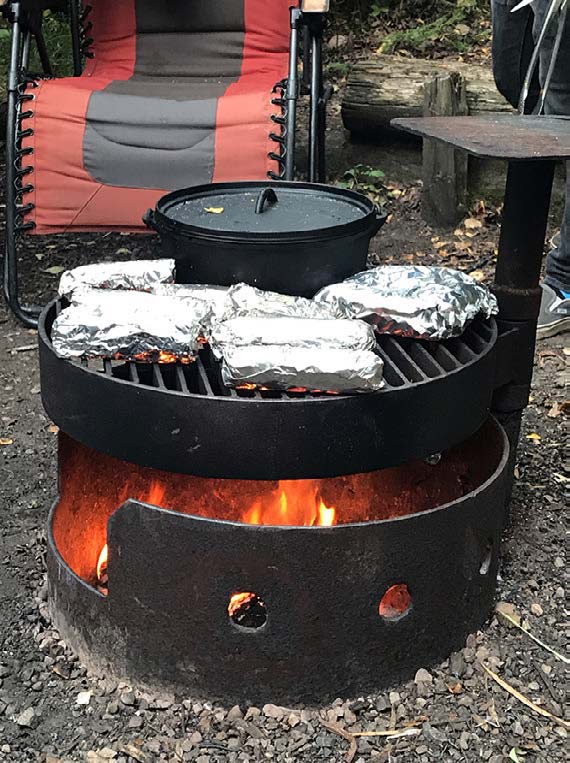Dutch ovens are the matriarch of cast iron with their strength and versatility. Here’s everything you need to know to select the right Dutch oven for your outdoor kitchen!
Why A Dutch Oven?
If cast iron were royalty, the Dutch Oven would be the queen of the family. A version of the cast iron Dutch Oven likely fed the early visitors to North America. Cast Iron is nearly indestructible and is the perfect platform on which to build an outdoor kitchen. From searing deer loin to simmering antelope curry, and baking sourdough to frying pancakes, the Dutch Oven does it all.
No need for detergent, just clean up with plain hot water. The only downside of cast iron is the weight, but if your gear can handle it, it might be the most versatile pot in camp.

I have a selection of Lodge Cast Iron in my hunting-camp. The Dutch Oven is my cooking vessel of choice. Need to deep fry shore lunch, or whistle up some cream and brandy simmered grouse legs? The Dutch oven competently delivers Antelope Osso Buco, Black Bear Bourguignon, and stir-fried pickerel cheeks. It is one of the most versatile and nearly indestructible pieces of equipment, and that’s why it should be part of every hunter’s gear. Whether making lunch on your tailgate or making dinner in your wall tent, whatever you make in the Dutch Oven will help feed everyone.
Here is what you need to know when selecting the right size and style for your needs; the optional equipment to add the most flexibility, and some hard-earned insight to get you started cooking great grub over live fire.
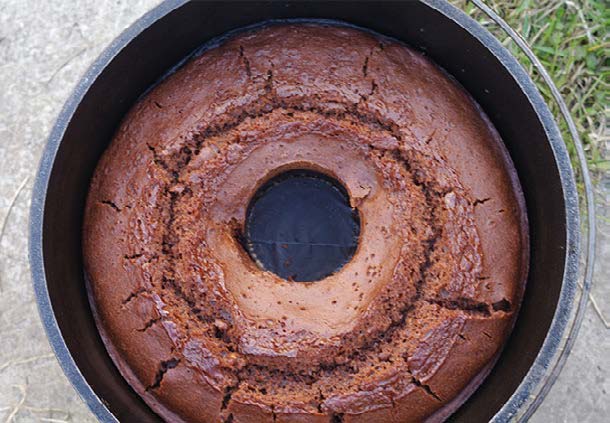
cake is the authors fave from his childhood Now he
makes it in the Dutch Oven just for fun
What makes a Dutch Oven a Dutch Oven?
A Dutch oven is simply a cast iron pot that is wider than it is deep, with a bale handle and a tight-fitting lid. Dutch ovens come in two basic categories: three-legged for cooking with (over and under) live coals or briquettes, and the flat-bottomed variety meant to be used on a stove top or over a burner.
Lids are design-specific to go with the Dutch ovens: a rimmed lid for the three-legged ovens to hold live coals or briquettes on top of the oven. These lids can be inverted and used as a dome-shaped griddle to sear bacon or fry eggs.
The plain, dome-shaped lids are for the flat-bottomed Dutch oven. Both can be hung on a tripod over live fire.
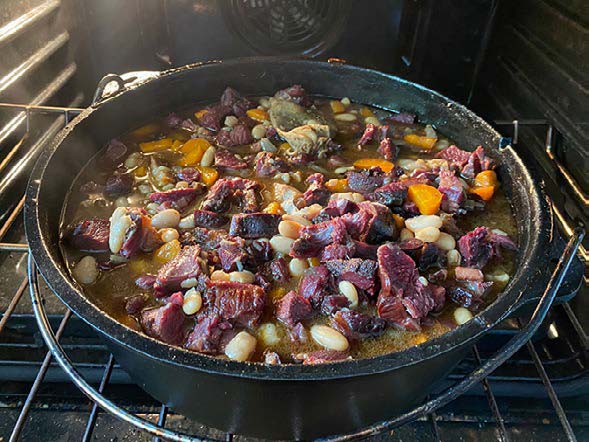
casserole
Choosing your Dutch Oven
Once you choose the style of Dutch Oven that best suits you, the next choice is whether to pick a shallow or a deep oven.
If you want to bake biscuits or bread, the shallow oven would be your first choice because the heat from the lid is closer to what’s being baked. The deeper version is the best choice for stew, roast meats, and casserole-type dishes.
Next is choosing the oven size. My preference is the 12″ variety, which is perfect for 4-6 diners.
Check Garage Sales
Often cast iron turns up at garage sales, a great place to snag a culinary deal. A decades-old oven that has been well maintained will function as well as a brand-new one, and maybe even better. The Wagner brand cast iron purchased when I was 16 has a slick base and is still in weekly use.
It’s worth pointing out that it’s also fine to own more than one oven. I happen to own five Dutch Ovens, including a couple of enameled ones for use at home. Lodge Manufacturing and CampChef manufacture excellent Dutch Ovens.
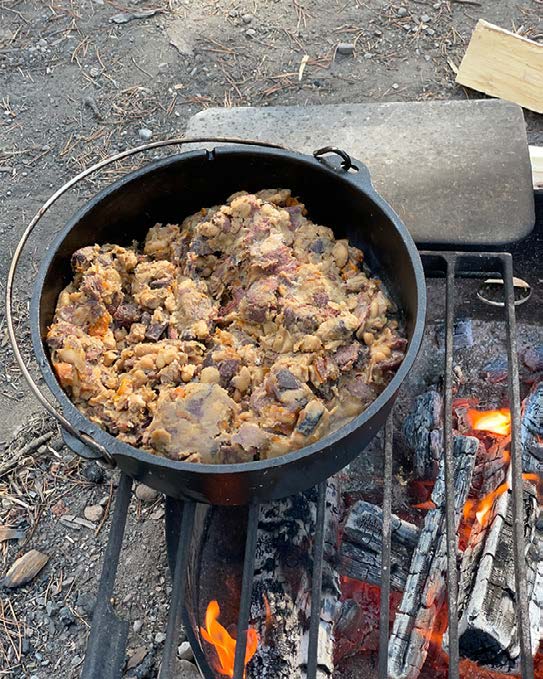
Managing Briquettes to Set Oven Temperature
It feels like some kind of culinary sorcery, but the formula in the Lodge cast iron Dutch oven manual tells you how to “set” your oven. Here’s how it goes:
- Measure the diameter of the Dutch oven (in inches)
- Multiply that number by 2
- Then, add 2
This gives you the number of briquettes to light up for a bake temperature of 350˚F.
It is neither random nor arbitrary, and 20+ years of cooking on cast iron will confirm that this formula works. However, you can conduct your own research, make notes, and adjust your process as required.
Here is the calculation in numbers:
- 12-inch diameter oven x 2 = 24
- Add 2 = 26 total
Once lit, put one-third of the briquettes (8) below and two-thirds (18) on top, and the resulting temperature will be very close to 350F. Need more heat? Add one briquette for every ten degrees Fahrenheit of desired temperature increase.
For example, to cook soda bread at 400˚F in your 12-inch oven, do the math like this:
- 12-inch diameter oven x 2 + 2 + (50˚ F / 10 = 5) for a new total of 31
- Put 11 briquettes underneath and the rest on
- Presto: 400˚F oven.
Standard briquettes yield standard heat. Once you get a feel for how this whole hot coal heating works, you can scoop coals from the campfire below and on top of your lipped Dutch Oven. It is worth noting that different woods give different heat, but let experience guide you. Experiment. I regularly use wood we cut from the boreal forest near my home. None of this wood is particularly heat-intense, but the food is always good.
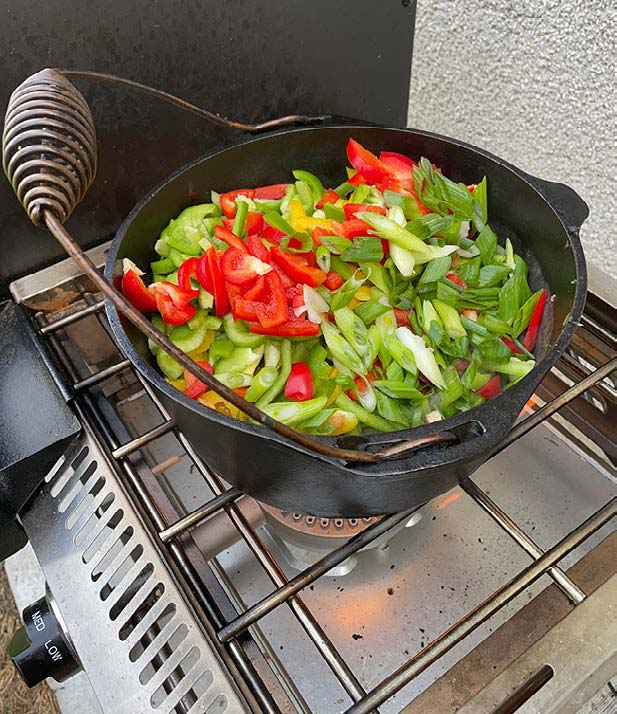
What Food is Best in a Dutch Oven?
Pretty much anything you would cook in a pot on your stove can be cooked in a dutch oven. What is a bit of a surprise is that over time you will learn that you can cook anything you would cook in your regular oven too! It is the perfect vessel to make soups and stews, but you can fry chicken, sear hare, or bake cabbage rolls. The more you use the Dutch oven the more you will become comfortable predicting how the oven works with a variety of meals and products. It is surprising how easy biscuits, cookies, and breads are to make in the Dutch oven. Soon it will be the center cook piece every trip out.
Accessories and Tools
The right accessories keep everyone safe and at the same time give Dutch oven users options to improve productivity.
- Lid lifter: This is a wrought iron tool that looks a little bit like a poker, but it is perfectly designed to pick up a lid full of hot coals.
- Storage and Carry Bags: These bags are oven-size-specific and keep your cast iron protected. Carry bags protect your oven while stored and keep the storage area clean. Dutch ovens can be sooty after hours on a fire, and these bags keep ovens separated well from the stored spaces.
- 4-in-1 Dutch Oven Tool: I call this a Spyder, and it is the perfect folding base to support a flat-bottom oven so you can put coals underneath it, use an inverted domed lid as a griddle, or as a place to rest a smoking hot lid or pot during service.
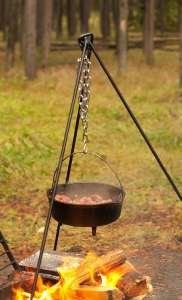
like the wild west
- Tripod: Lodge and other companies make a wrought-iron tripod that comes with an adjustable chain to hang the Dutch oven over the fire or coals. This is a great addition to a camp and gives another level of cooking flexibility.
Utensils and Clean-up
- Stir stick: I have a strong preference for wooden spoons, and my camping gear contains the various sizes and shapes I have come to enjoy best over the years. Conduct your own research and act accordingly.
- Chainmail Scrubbing Pad and rust eraser: Lodge makes this somewhat pricey piece of kit from stainless steel chainmail. It’s irreplaceable for keeping your cast iron clean.
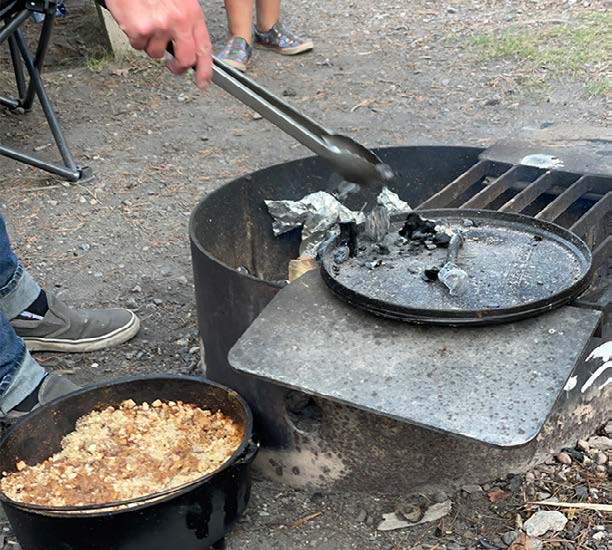
- Tongs: Working decades in commercial kitchens means my preference is for 12″ and 18″ heavy commercial food services type tongs. No wimps in camp––no wimpy gear either.
- Seasoning: There is a lot of chatter about how to care for your cast iron. It is simple: wipe it down with conditioner or oil to protect it from rust. Lodge has a proprietary blend but coconut oil well rubbed into the iron will do the job.
Food is a big part of enjoying the outdoors with friends and family and the Dutch Oven is indispensable in helping us accomplish this. It takes some time to get to know the capability of your Dutch oven and calibrate what it takes to cook on live fire. Savor the process and cook something wild to share with friends and family.
Per our affiliate disclosure, we may earn revenue from the products available on this page. To learn more about how we test gear, click here.



